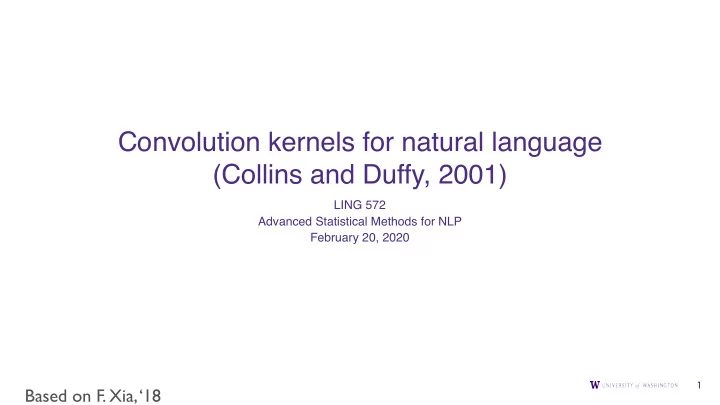

Convolution kernels for natural language (Collins and Duffy, 2001) LING 572 Advanced Statistical Methods for NLP February 20, 2020 1 Based on F. Xia, ‘18
Highlights ● Introduce a tree kernel ● Show how it is used for reranking 2
Reranking 3
Reranking ● Training data: ● Goal: create a module that reranks candidates ● The reranker is used as a post-processor. ● In this paper, build a reranker for parsing 4
Formulating the problem 5
Reranking: Training Recall that in SVM 6
Perceptron training 7
Tree kernel 8
A tree kernel 9
Intuition ● Given two trees T1 and T2, the more subtrees T1 and T2 share, the more similar they are. ● Method: ● For each tree, enumerate all the subtrees ● Count how many are in common ● Do it in an efficient way 10
Definition of subtree ● A subtree is a subgraph which has more than one node, with the restriction that entire (not partial) rule productions must be included. ● “A subtree rooted at node n” means “a subtree whose root is n”. 11
An example 12
C(n1, n2) C(n1, n2) counts the number of common subtrees rooted at n1 and n2. C(n1, n2) = ?? NP NP DT Adj N DT Adj N asweetapple asweetapple 13
Calculating C(n1, n2) If the productions at n1 and n2 are different then C(n1, n2) = 0 else if n1 and n2 are pre-terminals then C(n1, n2) = 1 else 14
Representing a tree as a feature vector h i ( T 1 ) = ∑ I i ( n 1 ) , where N 1 is the set of nodes in T 1 n 1 ∈ N 1 15
A tree kernel 16
Properties of this kernel ● The value of K(T1, T2) depends greatly on the size of the trees T1 and T2. ● K(T, T) could be huge. The output would be dominated by the most similar tree. => The model would behave like a nearest neighbor rule 17
Down-weighting the contribution of large subtrees when calculating C(n1, n2) If the productions at n1 and n2 are different then C(n1, n2) = 0 else if n1 and n2 are pre-terminals then else 18
Experimental results 19
Experiment setting ● Data: ● Training data: 800 sentences, ● Dev set: 200 sentences ● Test set: 336 sentences ● For each sentence, 100 candidate parse trees • Learner: voted perceptron ● Evaluation measure: 10 runs and report the average parse score ● Baseline (with PCFG): 74% (labeled f-score) 20
Results With different max subtree size 21
Summary ● Show how to use a SVM or a perceptron learner for the reranking task. ● Define a tree kernel that can be calculated in polynomial time. ● Note: the number of features is infinite. ● The reranker improves parse score from 74% to 80%. 22
Recommend
More recommend